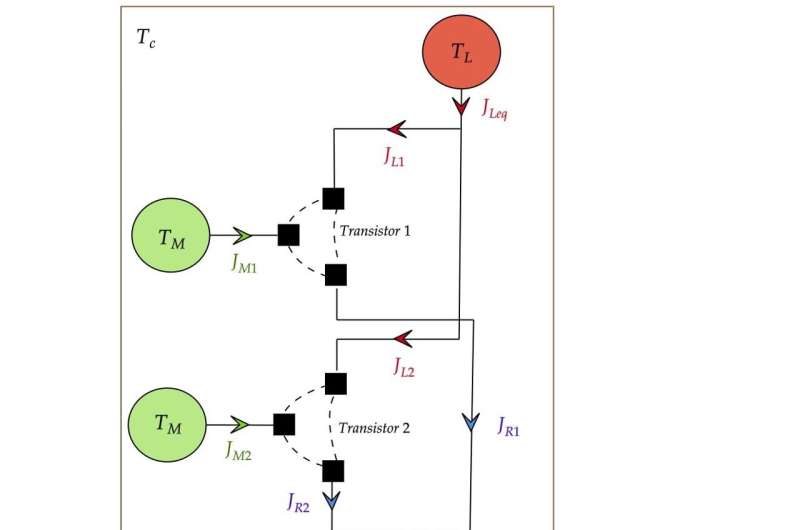March 13, 2023 dialog
This article has been reviewed according to Science X's editorial process and policies. Editors have highlighted the following attributes while ensuring the content's credibility:
fact-checked
peer-reviewed publication
trusted source
written by researcher(s)
proofread
Revisiting semiconductor heat management through nanotechnology

Nanotechnology has significantly impacted the semiconductor industry, enabling the production of transistors that are just a few nanometers in size. While the miniaturization of electronic components has resulted in higher transistor densities, it has also increased heat generation.
To address this, current thermal technology relies on thermoelectric cooling modules, liquid coolants and heat sinks to dissipate heat. However, we envision a future when nanotechnology plays a crucial role in developing miniature cooling and energy-harvesting devices that can be seamlessly integrated with electronic circuits. Our research is motivated by this vision, and we are working to advance the field by exploring novel nanomaterials and device architectures for efficient heat management and energy harvesting.
How can we control heat generation in a novel way?
The manipulation of quantum resources in the electronics industry holds great potential for building innovative devices aimed at controlling heat generation. Advancements in this field rely heavily on theoretical foundations and basic design principles involving the theory of open quantum systems. By developing a better understanding of these concepts, researchers can create faster and more efficient cooling strategies for cutting-edge electronics.
However, extensive research is needed to fully establish the theory of energy transfer in thermal devices, especially when these systems are strongly coupled to their surrounding environment. Before thermal device models can be brought to the fabrication stage, it's crucial to explore the area of quantum thermal management in-depth.
One such example of an open quantum system is the thermal transistor, which interacts with a collection of thermal baths. Two-level systems represent the terminals of the transistor. In a quantum thermal transistor, three such systems interact with three thermal baths with different temperatures directly coupled. Once configured, the thermal transistor behaves similarly to an electronic transistor. By connecting multiple thermal transistors through baths, researchers can create a multi-transistor system with the potential to generate various thermal counterparts of electronics.
Novel perspective for future electronic industry
As detailed by research published in Physical Review B, we have developed a novel theoretical model for thermal energy control using a multi-transistor structure, which enables the guidance of heat flow like electricity. Unlike previous studies that utilized single structures, we used rings of two-level systems connected to various baths to achieve our model, which enhanced the ability to amplify heat currents.
Our model is efficient as it can be placed on a substrate, opening the way to a practical quantum thermal transistor design. We investigated how common environmental effects and reservoir engineering techniques can be utilized to generate dark-states, leading to the realization of thermal logic gates.
Although our research is still focused on the experimental realization of these models, they have the potential to revolutionize how we approach efficient thermal management in modern electronics. The on/off action of these thermal transistors could be used to cool electronic circuits, presenting a novel implication for future electronics.
This story is part of Science X Dialog, where researchers can report findings from their published research articles. Visit this page for information about ScienceX Dialog and how to participate.
More information: Uthpala N. Ekanayake et al, Engineered common environmental effects on multitransistor systems, Physical Review B (2023). DOI: 10.1103/PhysRevB.107.075440
Ravi T. Wijesekara et al, Darlington pair of quantum thermal transistors, Physical Review B (2021). DOI: 10.1103/PhysRevB.104.045405
Bio:
Uthpala Nivandani Ekanayake earned her B.Sc. electrical and electronic engineering (with first-class honors) from University of Peradeniya, Sri Lanka. Currently she is a PhD student and a member of the Advanced Computing and Simulations Laboratory (qdresearch.net/) at the Department of Electrical and Computer Systems Engineering, Monash University, Australia under the supervision of Prof. Malin Premaratne.
Malin Premaratne earned several degrees from the University of Melbourne, including a B.Sc. in mathematics, a B.E. in electrical and electronics engineering (with first-class honors), and a PhD in 1995, 1995, and 1998, respectively. He has been leading the research program in high-performance computing applications to complex systems simulations at the Advanced Computing and Simulation Laboratory, Monash University, Clayton, since 2004. Currently, he serves as the Vice President of the Academic Board of Monash University and a Full Professor. In addition to his work at Monash University, Professor Premaratne is also a Visiting Researcher at several prestigious institutions, including the Jet- Propulsion Laboratory at Caltech, the University of Melbourne, the Australian National University, the University of California Los Angeles, the University of Rochester New York, and Oxford University. He has published more than 250 journal papers and two books and has served as an associate editor for several leading academic journals, including IEEE Photonics Technology Letters, IEEE Photonics Journal, and OSA Advances in Optics and Photonics. Professor Premaratne's contributions to the field of optics and photonics have been recognized with numerous fellowships, including the Fellow of the Optical Society of America (FOSA), the Society of Photo-Optical Instrumentation Engineers USA (FSPIE), the Institute of Physics U.K. (FInstP), the Institution of Engineering and Technology U.K. (FIET), and The Institute of Engineers Australia (FIEAust).
Journal information: Physical Review B





















